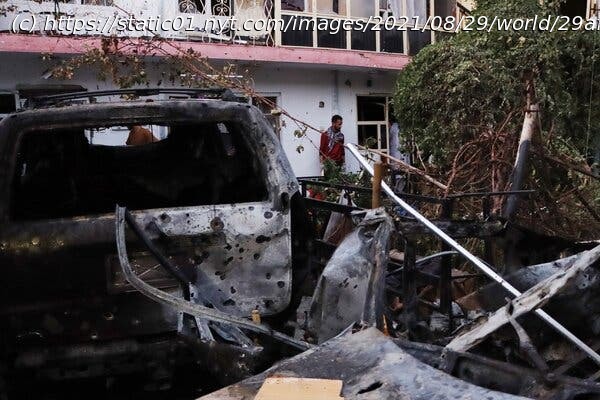The attack on the Afghan capital was said to target a car full of explosives and came hours after the United States had warned that another terrorist assault was “highly likely.”
The attack on the Afghan capital was said to target a car full of explosives and came hours after the United States had warned that another terrorist assault was “highly likely.” U.S. diplomats are unlikely to stay in Afghanistan after troops leave. Biden witnesses the return of service members killed in the Kabul airport bombing. Dozens of countries say they will accept Afghan refugees after Aug.31. The U.K. ambassador returns home as his country’s last troops leave Kabul. Some Afghans say that enemies of the Taliban have begun to disappear. ‘Heartbreaking and terrifying.’ Two nonprofit groups are making a last-minute attempt to help Afghan women escape. Two House members defend their unauthorized trip to the Kabul airport. What we know about the 13 U.S. service members killed in the Kabul attack. A U.S. military drone strike blew up a vehicle laden with explosives in Kabul on Sunday, a Defense Department official said, hours after President Biden had warned that a terrorist attack against the Afghan capital’s airport was “highly likely.” The strike eliminated “an imminent ISIS-K threat to Hamad Karzai International airport,” U.S. Central Command, Capt. Bill Urban said, referring to the Islamic State Khorasan group. “Significant secondary explosions from the vehicle indicated the presence of a substantial amount of explosive material.” Captain Urban said the military was trying to determine whether the strike had injured civilians. A senior military official said the military was confident no civilians were in the targeted vehicle but acknowledged that the secondary explosions may have caused damage. Zabihullah Mujahid, a spokesman for the Taliban, said civilians had suffered casualties in the U.S. strike. “We are investigating the reason of the airstrike and the exact number of casualties,” he said. Earlier Sunday, the United States Embassy in Kabul had said that there was a “specific, credible threat” to the airport area, where a suicide bombing on Thursday killed about 170 civilians and 13 members of the American military. State Department officials have issued several similar warnings in recent days. With just two days left before Mr. Biden’s Tuesday deadline to complete the U.S. troop withdrawal from Afghanistan, the military was shifting its focus from vetting and airlifting Afghan and American civilians to bringing its own personnel home. On Sunday morning, American University of Afghanistan students and their families boarded buses bound for the airport, on what could prove to be the last day of civilian evacuations. Some 300 American citizens still remain in Afghanistan, the national security advisor, Jake Sullivan, said in an interview on Fox News Sunday. The American troop departures will mark the tumultuous end to a 20-year war that has left the country awash in grief and desperation, with many Afghans fearing for their lives under Taliban rule and struggling to support their families amid cash shortages and rising food prices. At least some banks had opened in Kabul on Sunday, and long lines had formed outside their doors. The attack at the airport on Thursday, which happened as U.S. troops were screening people hoping to enter, once again underscored the human toll of the war — both for Afghans, the overwhelming majority of the victims, and for the American families who lost loved ones sent to fight it. The 13 American military personnel who were killed came from across the country, from California to Wyoming to Tennessee, and had an average age of just over 22. Eleven were Marines, one was a Navy medic and another was in the Army. About 113,500 people, most of them Afghans, have been evacuated since Aug.14, a Pentagon official said, the day before the Taliban seized Kabul. On Saturday, about 1,400 people were still at the airport, having been screened and booked for flights, Pentagon officials said. Hundreds of thousands of Afghans are still thought to be trying to flee the country. Mr. Biden and other global leaders have acknowledged that many will not get out before the deadline. Jim Huylebroek contributed reporting. — Helene Cooper, Dan Bilefsky and Eric Schmitt The United States is unlikely to keep diplomats in Afghanistan after the U.S. military departs on Tuesday, Secretary of State Antony J. Blinken said on Sunday, ending a 20-year mission of one of the largest American embassies in the world. Officials said it was expected that the U.S. mission to Afghanistan would open a diplomatic mission in a country elsewhere in the region, in part to continue helping the surge of expected refugees obtain necessary departure documents. That effort could be based in Pakistan or the United Arab Emirates, an official said, given the large Afghan diaspora in both countries. American diplomats have also for years held peace talks with the Taliban in Qatar, where there is a large U.S. military base that is being used now as a way station for tens of thousands of Afghans who have been evacuated. After saying last week that the Biden administration was reviewing options for the future of the embassy in Kabul, Mr. Blinken told NBC’s “Meet the Press” on Sunday that “in terms of having an on-the-ground diplomatic presence on Sept.1, that’s not likely to happen.” “But what is going to happen is that our commitment to continue to help people leave Afghanistan who want to leave and who are not out by Sept.1, that endures,” Mr. Blinken said. “There’s no deadline on that effort. And we have ways, we have mechanisms to help facilitate the ongoing departure of people from Afghanistan if they choose to leave.” The Taliban had wanted the United States and other foreign diplomats to remain in Kabul as acknowledgment of the Taliban’s legitimacy as Afghanistan’s rulers. Ending the American diplomatic presence in the country will be a blow to the U.S. diplomatic corps. Hundreds of American diplomats served in Afghanistan after the embassy was reclaimed by Marines in December 2001 during the U.S.-led invasion. It had been closed since 1989, when the Soviet military withdrew from Afghanistan after a 10-year war. The diplomatic mission’s staffing levels ballooned during a so-called civilian surge that coincided with an increase in military troops that began in 2010. The embassy compound in Kabul later expanded, with hundreds of millions of dollars in additional office space, employee apartments, fortified gates and blast walls over 15 acres, about the size of Liberty Island in New York Harbor. Just weeks before the embassy closed on Aug.15, as the Taliban took over the capital, its staff stood at about 4,000 employees, around 1,400 of whom were American diplomats, contractors and officials from other U.S. agencies. Nonessential employees had been flown out months before, and by the time the American flag was lowered two weeks ago, only a small core of diplomats remained to be evacuated to a secure compound at the international airport where they could be protected by the military. Now, with the military departing — as part of an agreement with the Taliban — the State Department saw little choice but to also withdraw its diplomats. — Lara Jakes DOVER AIR FORCE BASE, Del. — President Biden landed in Delaware on Sunday morning to join the families of the 13 members of the U.S. military who were killed in a bombing last week in Afghanistan. The service members include 11 Marines, a Navy medic and a member of the Army. They were killed at the airport in Kabul, the capital of Afghanistan, by a bomber from the Islamic State Khorasan group as they attempted to help people escape the country before American troops complete their withdrawal. The president and first lady, Jill Biden, met with the families on Sunday morning. They then participated in 13 transfers — 11 for families who chose to allow media to observe the remains of their loved ones returning home, and two for families who chose to keep their transfers private. The fallen service members returning Sunday to Dover were: Marine Corps Staff Sgt. Darin T. Hoover,31, of Salt Lake City; Marine Corps Sgt. Johanny Rosario Pichardo,25, of Lawrence, Mass.; Marine Corps Sgt. Nicole L. Gee,23, of Sacramento, Calif.; Marine Corps Cpl. Hunter Lopez,22, of Indio, Calif.; Marine Corps Cpl. Daegan W. Page,23, of Omaha; Marine Corps Cpl. Humberto A. Sanchez,22, of Logansport, Ind.; Marine Corps Lance Cpl. David L. Espinoza,20, of Rio Bravo, Texas; Marine Corps Lance Cpl. Jared M. Schmitz,20, of St. Charles, Mo.; Marine Corps Lance Cpl. Rylee J. McCollum,20, of Jackson, Wyo.; Marine Corps Lance Cpl. Dylan R. Merola,20, of Rancho Cucamonga, Calif.; Marine Corps Lance Cpl. Kareem M. Nikoui,20, of Norco, Calif.; Navy Hospitalman Maxton W. Soviak,22, of Berlin Heights, Ohio; and Army Staff Sgt. Ryan C. Knauss,23, of Corryton, Tenn. Mr. Biden stood at attention with his right hand over his heart as service members in varying shades of green fatigues — first for the Army, then the Marines, then the Navy — carried flag-draped transfer cases containing remains of the fallen from the belly of a gray C-17 transport plane to a fleet of four gray vans with their back doors open. The carry teams, as they are called, worked in three-minute cycles, with the public set of 11 transfers lasting just under 40 minutes total, including a prayer at the beginning. In between transfers, the president spread his legs wider, clasped his hands at his belt or behind his back, and frequently closed his eyes and bowed his head. A large group of federal dignitaries were on hard for the transfers, including Defense Secretary Lloyd J. Austin III; Secretary of State Antony J. Blinken; Gen. Mark A. Milley, chairman of the Joint Chiefs of Staff; and several members of Congress. One observer, who the White House later identified as Martha Carper, the wife of Senator Tom Carper, Democrat of Delaware, appeared to faint midway through one of the transfers. The White House did not announce the trip in advance. It is the first time Mr. Biden has witnessed the return of service members killed in the line of duty since assuming the presidency. The men and women killed in the Kabul attack were the first American service members killed by hostile forces since March 2020. Mr. Biden witnessed a transfer as vice president in 2016. “The 13 service members that we lost were heroes who made the ultimate sacrifice in service of our highest American ideals and while saving the lives of others,” Mr. Biden said in a written statement released on Saturday. “Their bravery and selflessness has enabled more than 117,000 people at risk to reach safety thus far.” — Jim Tankersley The United States and 97 other countries said on Sunday that they would continue to take in people fleeing Afghanistan after the American military departs this week and had secured an agreement with the Taliban to allow safe passage for those who are leaving.






